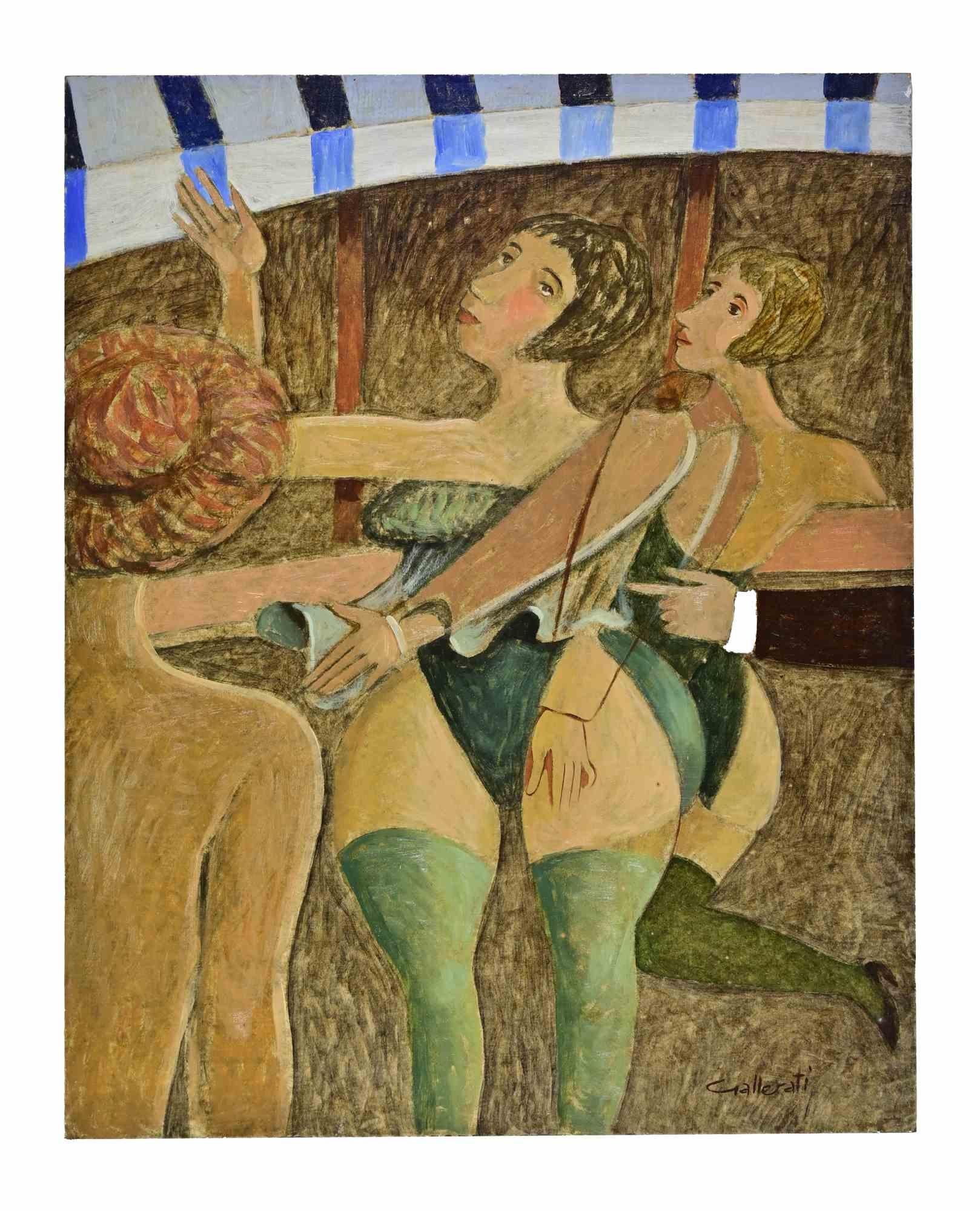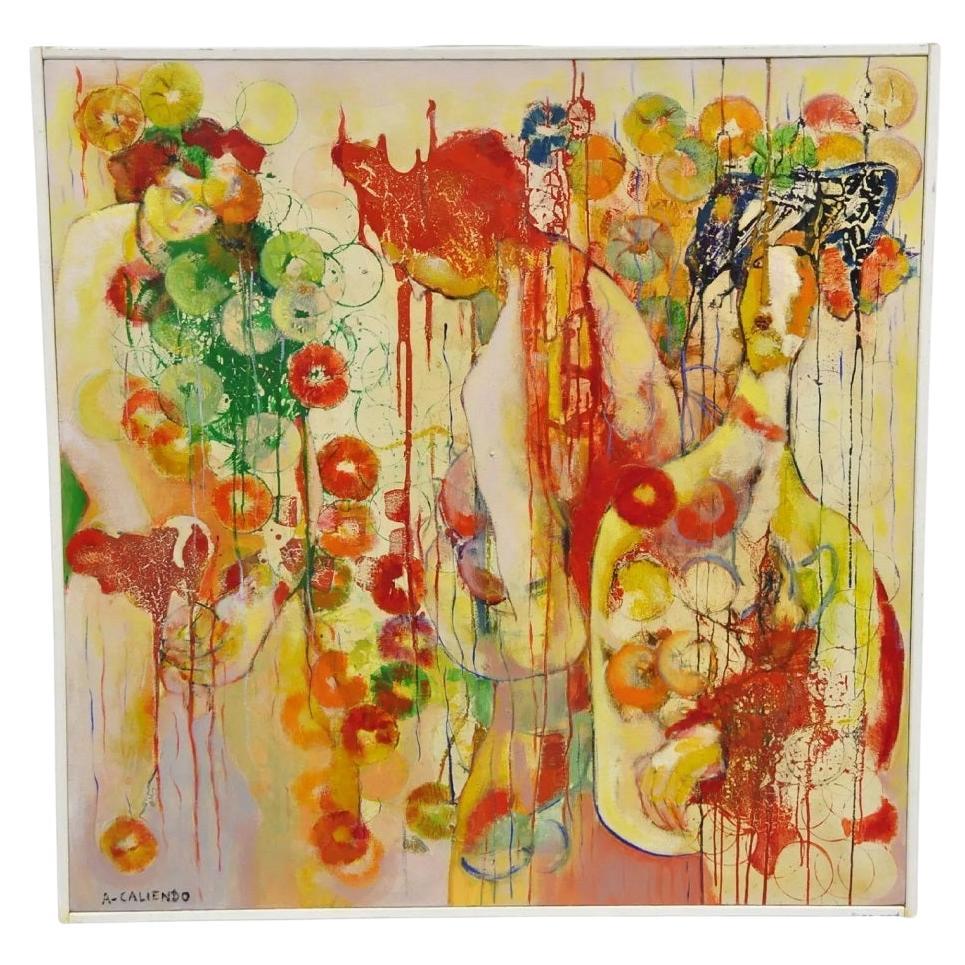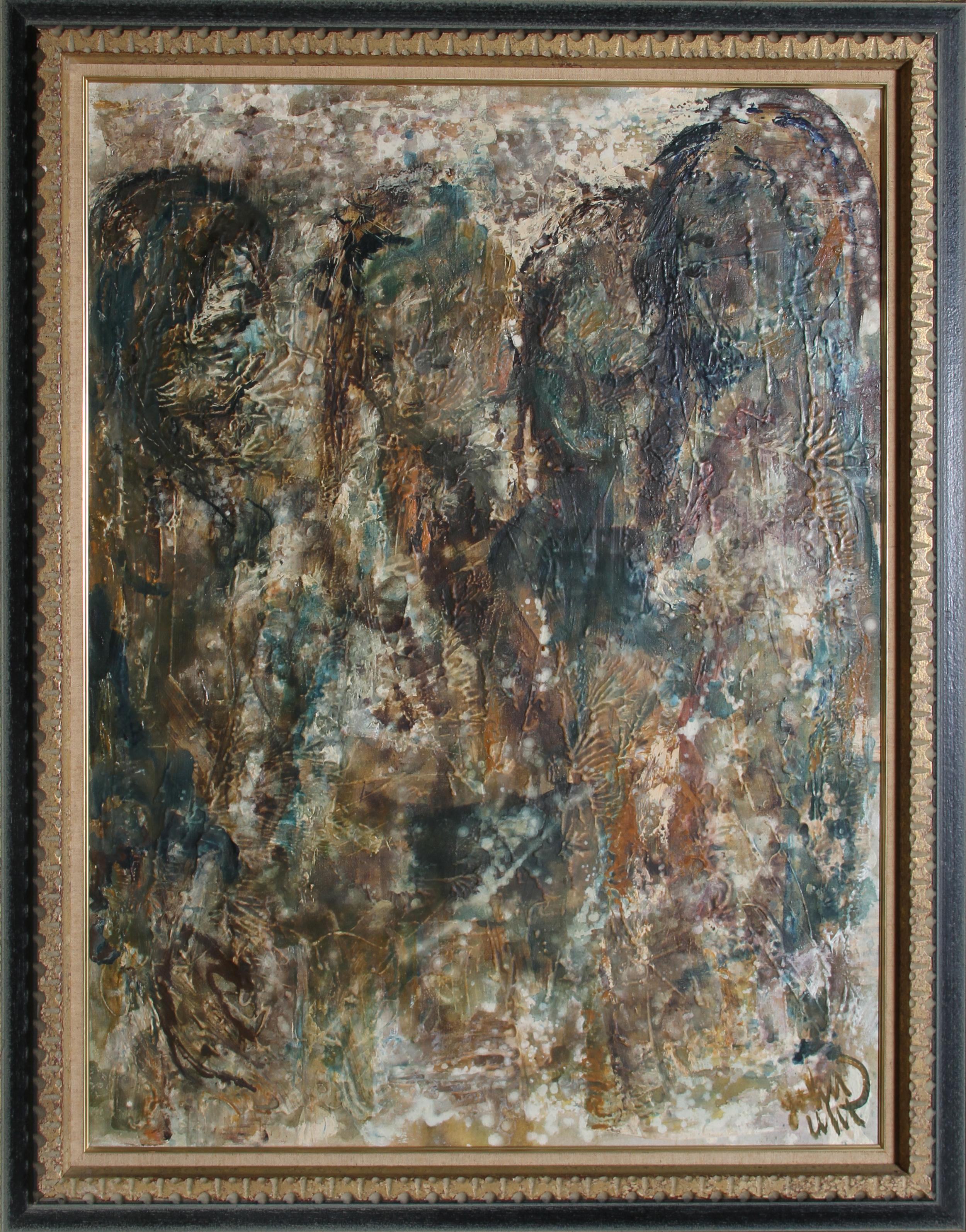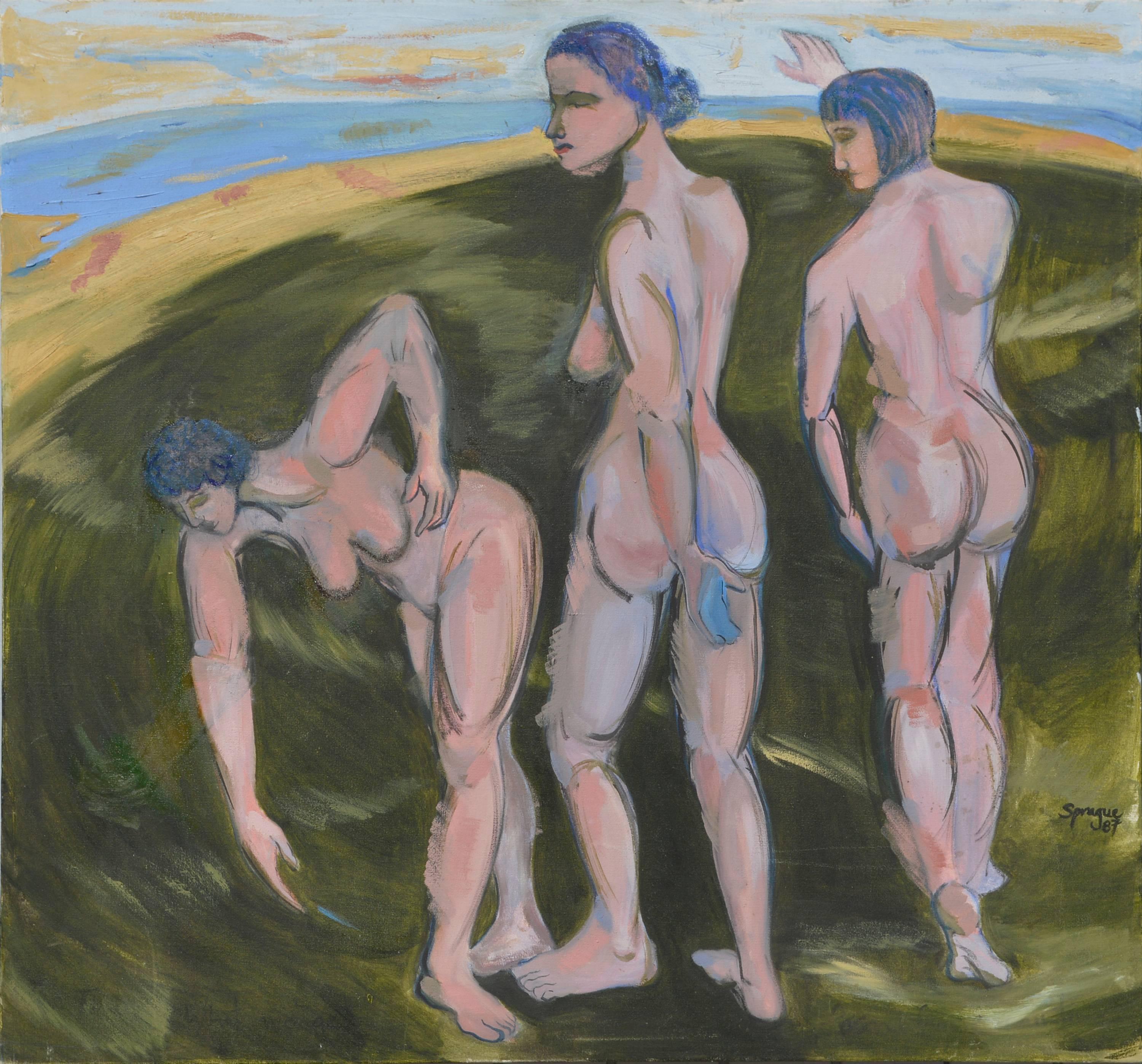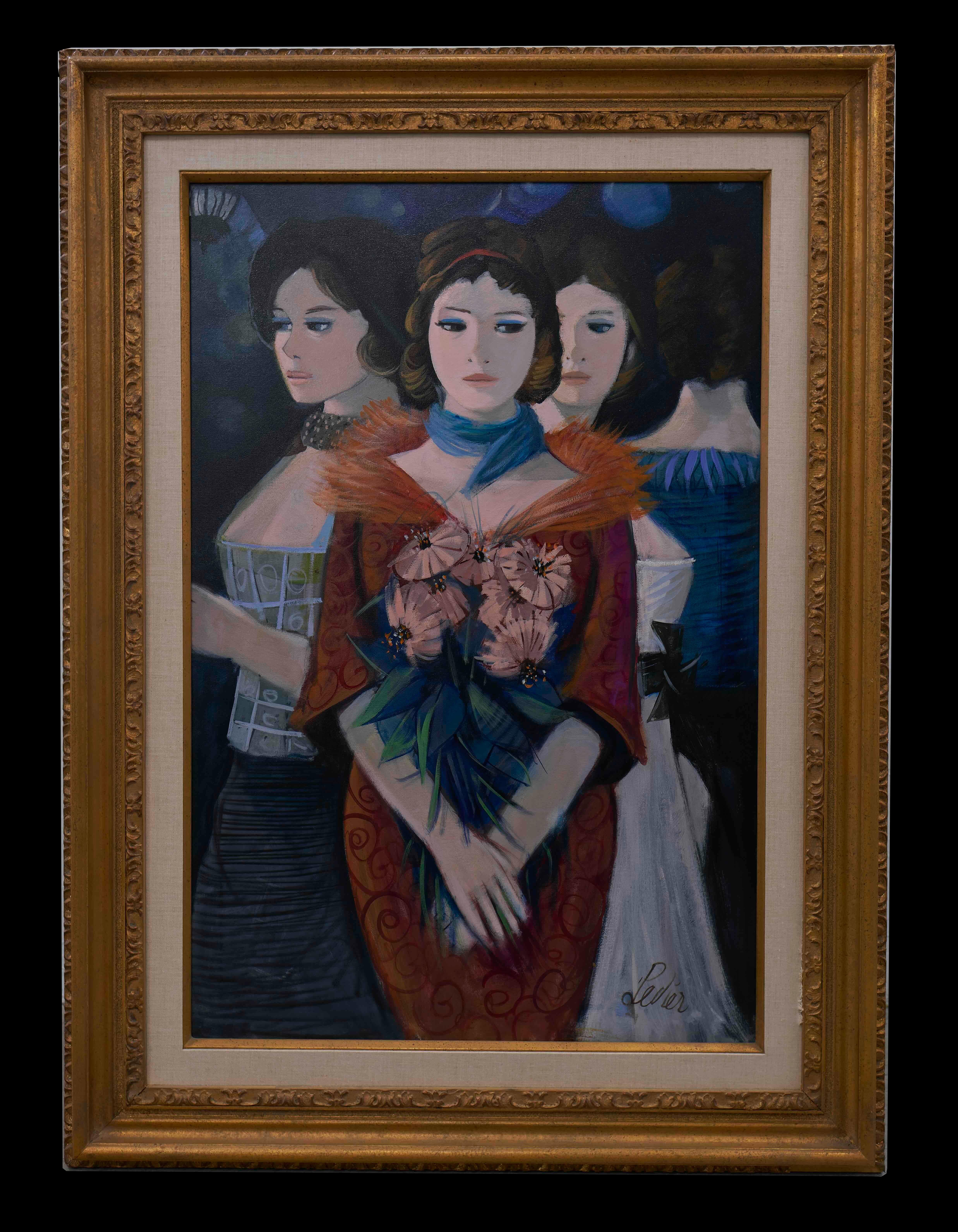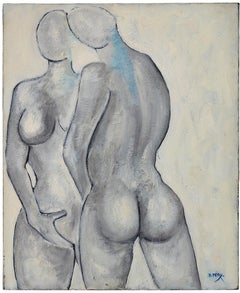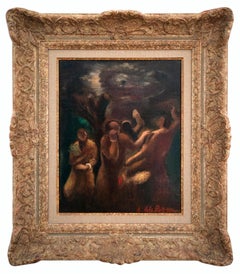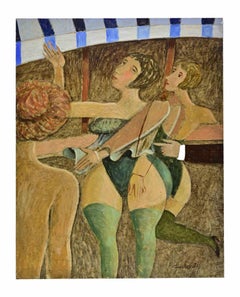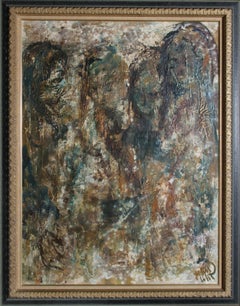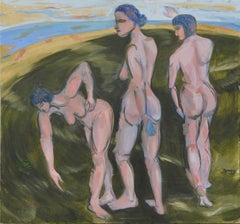Items Similar to Edouard Goerg, Les 3 Brunes, Large Oil on Canvas, 1955
Want more images or videos?
Request additional images or videos from the seller
1 of 11
Edouard GoergEdouard Goerg, Les 3 Brunes, Large Oil on Canvas, 19551955
1955
$15,000
£11,283.60
€13,071.52
CA$21,146.90
A$23,516.76
CHF 12,340.87
MX$286,775.55
NOK 155,992.99
SEK 146,249.64
DKK 97,564.28
About the Item
Large oil on canvas by Edouard GOERG (1893-1969), France, 1955. LES 3 BRUNES. With frame : 114x95cm - 44.9x37.4 inches ; without frame : 92.2x73 cm - 36.3x28.75 inches. Format 30F. Signed "E.Goerg" (see photo). On the back, inscription by the hand of the painter "Les 3 brunes E. Goerg mai-Juin 1955". One of his masterpieces in theme and format! Edouard Goerg possessed an immediately identifiable and particularly poetic style, which made him one of the most sought-after French painters of his time. One could draw many comparisons between her life and that of Chagall, both marked by the death of adored wives, and by the emergence of the work that followed. On this subject, art critics comparing the work of the two painters wondered which of the two was at the origin of the flowery themes developed, on the one hand, by Edouard Goerg through his flower-women and, on the other hand, by Marc Chagall in the continuation of his work. hus Goerg developed a dreamlike imagination highly prized by collectors, where women and flowers would become inseparable.
Édouard Goerg is one of the major artists of his generation. Coming from a Champagne family, he was born in Sidney, Australia, in 1893, during a professional stay of his father. After passing through London, he arrives in Paris at the age of seven. At twenty, between 1913 and 1914, he studieds painting at the Académie Ranson with Maurice Denis and Paul Sérusier. He travels to Italy and India. Mobilized in 1914, he is sent to Artois, then to Argonne. From 1920, he exhibits at the Salon des Independants, then at the Salon d'Automne where he joins with Laboureur. At Berthe Weil, in 1924, he participates in the exhibitions of the Gromaire group, a prelude to a series of exhibitions in Paris (Berthe Weill, Bernheim Jeune), as in Brussels (Le Centaure). Goerg illustrates books including Table of the beyond by F.Boutet. In 1928, he meets Paul Guillaume who exhibits his works in Boston and the Art Institute of Chicago. He continues to show his works, satires of the bourgeois manners, at Bernheim Jeune, then at Lucie Krogh. In 1934, he travels to Belgium and Holland where he paints surrealist paintings that will be exhibited at Jeanne Castel. In 1935-1936, he meets Aragon, who opened the doors of the houses of the cultures created by the Association of Writers and Revolutionary Artists. The Spanish war and the Second World War mark it deeply. He must protect his daughter and his Jewish women against the pursuit of the Nazis. The latter will die by lack of care. In 1949, Goerg is appointed professor of Fine Arts and teaches at the Grande Chaumière. He is elected to the Academy of Fine Arts in 1965. He dies in 1969.
" His satirical verve is that of a Toulouse-Lautrec of the Roaring Twenties. Goerg instigates the world from which he comes, his ceremonial, morgue and the falsity of important people " (Michel Charzat, La jeune peinture française)
In the paintings of his early period he attacks the morality of post-war bourgeois society, and in that sense was similar to expressionist painters like Georg Grosz. The major works of this period are: Pirate (1922); Gourmand (1923); Bar (1923); Marriage (1924); Window (1924); Don Quixote (1925); and Good fortune (1925). He travels extensively, and in 1935 visits the museums of Holland, where he is deeply influenced by the works of Hieronymus Bosch and Bruegel. He then directs a series of paintings on the theme of the tragedy of the human condition, under the generic title: "eThis is how the world turns under the eye of the police".
After the Second World War, he savs his vitriolic commentary for his etchings, and in his paintings ceased to criticize real life and instead celebrated the evil charms of the flower-girls. He illustrates many books, including: Tales of Hoffmann, Picture of the Beyond by Frederick Boutet, Knock by Jules Romains, The Flowers of Evil by Charles Baudelaire, The Book of Job and Apocalypse of St. John by Sir Isaac Newton, who have all demonstrated his engraving skills. Asked about his art, he confesses that he had first wanted to try to unblock the "comedy of everyday forms". Essentially a painter of figures, he generally paints groups of feminine nudes; however, these nudes are often accompanied by conservatively dressed male spectators, who are the most enduring symbol of his first comic intentions. Nevertheless, the comedy is loaded with bitterness and sarcasm.
After several refusals, he is accepted at the Salon des Artistes Indépendants in 1922. His work then appears at the Salon d'Automne, at the Salon des Tuileries, at the Salon des Peintres Témoins of Their Time and at the Salon of the Society of Painters-Engravers, where he becomes honorary president from 1945 to 1958. He makes his first personal exhibition in Paris in 1925. After that, he exhibits regularly in France and abroad. There have been several retrospectives of his work, notably in 1988 at the Grand Palais in Paris and the Salon du Verney in Vichy. In 1949, he receives the very prestigious Hallmark prize for Nativity. In 1950 he receives the Lugano Prize for Engraving.
"In the mid-twenties, he developed his plastic code: canvases with a flat surface, a chromatic range that has brightened with phosphorescent blues and greens, a craft that wants to transcend the subject by intrinsic beauty. Goerg works with the patience of the alchemist his paste that he superimposes to obtain the sumptuousness of enamels. A pictorial magic unifies the different periods of the work" (Michel Charzat, La jeune peinture française)
- Creator:Edouard Goerg (1983-1969, French)
- Creation Year:1955
- Dimensions:Height: 44.89 in (114 cm)Width: 37.41 in (95 cm)Depth: 2.76 in (7 cm)
- Medium:
- Movement & Style:
- Period:
- Condition:
- Gallery Location:Saint Amans des cots, FR
- Reference Number:1stDibs: LU1088214859822
About the Seller
5.0
Vetted Professional Seller
Every seller passes strict standards for authenticity and reliability
1stDibs seller since 2018
38 sales on 1stDibs
- ShippingRetrieving quote...Shipping from: Saint Amans des cots, France
- Return Policy
Authenticity Guarantee
In the unlikely event there’s an issue with an item’s authenticity, contact us within 1 year for a full refund. DetailsMoney-Back Guarantee
If your item is not as described, is damaged in transit, or does not arrive, contact us within 7 days for a full refund. Details24-Hour Cancellation
You have a 24-hour grace period in which to reconsider your purchase, with no questions asked.Vetted Professional Sellers
Our world-class sellers must adhere to strict standards for service and quality, maintaining the integrity of our listings.Price-Match Guarantee
If you find that a seller listed the same item for a lower price elsewhere, we’ll match it.Trusted Global Delivery
Our best-in-class carrier network provides specialized shipping options worldwide, including custom delivery.More From This Seller
View AllDominique PERY, Marianne, Oil on canvas 1987
Located in Saint Amans des cots, FR
Oil on canvas by Dominique PERY, France, 1987. Nude named "Marianne". 73x60 cm - 28.75x23.6 in. 20F Format. Signed "D.Péry" lower right (see photo). Countersigned twice and dated 198...
Category
1980s Neo-Expressionist Figurative Paintings
Materials
Canvas, Oil
Toujours la Vie Recommence
By Edouard Goerg
Located in Saint Amans des cots, FR
Oil on canvas by Edouard Goerg (1893-1969), France, 1958. Life is always the same. Acquired in 2017 from the personal collection of Edouard Goerg. Measurements : with frame : 62.5x53.4 cm - 24.6x21 inches, without frame : 55x46 cm - 21.7x18.1 inches, format 10F. Signed "E.Goerg" (see photo).
Preserved by the painter, then by his family since his death in 1969, this painting appeared in 2017. Entitled "Always life begins again", it is a crepuscular work. Testamentary one could say, so much the statement which is made there is definitive. The fact that he kept it until his death tends to consolidate this vision. Far from the empty looks and death faces of the rebellious era of sarcastic expressionism, the terrifying and compassionate testimony of the Spanish war, and the post-WWII flower women, we are dealing here with a a form of reasonable abdication, but honest. This idea that although everything changes, nothing changes. Changed times, actors, ideas, the same comedy occupies the society. Having given up the idea of changing the latter, Goerg accepts the fact that the only alternative is to stay there or get lost. But stay afloat with his values, completely independent, whatever the cost is.
This work is similar to La Vie Recommence of 1935, reproduced on page 54 of Gaston Diehl's book devoted to the painter (Éditions de Clermont, 1947). On the latter, the artist depicts his vision of life, from birth to death, made of hope, fear, cruelty, resignation and fatality. 23 years later, Toujours La Vie Recommence shows us the road traveled by the painter. It is no longer a matter of denunciation, but ultimately of acceptance of reality and the difficulty of staying there yourself.
The admirer of Hieronymus Bosch gives us an inspired composition. The hand of God, the only expression of physical beauty in this work, comes down from heaven to give life. Symbolically, it holds an egg that dispenses the element from which the human protagonists find their birth, and in which they move and tangle more than they impose. Beautiful allegory of society. Four characters, two women and two men evolve in this societal marigot. The man in the foreground, ruddy face, evolves with ease. His body is supple, flexible, adaptable. The woman on the left observes him with admiration. Obviously, this man is in his place and causes rapture. The right man with massive shoulders and wrapped, shows a physical maladjustment to the activity he is doing. He struggles to stay afloat, his face expresses effort, even exhaustion. But he assumes. He does with what he has, with what he is. The other woman shows him the greatest indifference. What is not the case of the demonic archangel (recurrent in the works of Bosch) with the stunted body, who leads the dance and holds this character, we understand the painter, under his control as to have fun. As this character cannot change bodies, Goerg cannot change values. He does it with. Had he not said to the critic Roger Brielle: "Independents, sensitive and just men, that's what we must strive to stay in this world in disarray". Goerg will have come to narrative expressionism to give us a balance sheet allegory of his deep self and his condition.
Édouard Goerg is one of the major artists of his generation. Coming from a Champagne family, he was born in Sidney, Australia, in 1893, during a professional stay of his father. After passing through London, he arrives in Paris at the age of seven. At twenty, between 1913 and 1914, he studieds painting at the Académie Ranson with Maurice Denis and Paul Sérusier. He travels to Italy and India. Mobilized in 1914, he is sent to Artois, then to Argonne. From 1920, he exhibits at the Salon des Independants, then at the Salon d'Automne where he joins with Laboureur. At Berthe Weil, in 1924, he participates in the exhibitions of the Gromaire group, a prelude to a series of exhibitions in Paris (Berthe Weill, Bernheim Jeune), as in Brussels (Le Centaure). Goerg illustrates books including Table of the beyond by F.Boutet. In 1928, he meets Paul Guillaume who exhibits his works in Boston and the Art Institute of Chicago. He continues to show his works, satires of the bourgeois manners, at Bernheim Jeune, then at Lucie Krogh. In 1934, he travels to Belgium and Holland where he paints surrealist paintings that will be exhibited at Jeanne Castel. In 1935-1936, he meets Aragon, who opened the doors of the houses of the cultures created by the Association of Writers and Revolutionary Artists. The Spanish war and the Second World War mark it deeply. He must protect his daughter and his Jewish women...
Category
1950s Expressionist Figurative Paintings
Materials
Canvas, Oil
School of Paris, Barbara, Oil on Canvas, 1950s
Located in Saint Amans des cots, FR
This captivating 1950s oil on canvas portrait, possibly depicting the French singer Barbara, exudes an air of mystery and existential reflection. While the identity of the subject re...
Category
1950s Neo-Expressionist Figurative Paintings
Materials
Canvas, Oil
Amedee de La PATELLIERE, Eclipse with 4 Characters, 1928
Located in Saint Amans des cots, FR
Oil on canvas by Amedee de La PATELLIERE, France, 1928. Eclipse with four characters. With frame: 63x54 cm - 24.8x21.25 inches ; without frame: 41x33 cm - 16.15x13 inches. Format 6F....
Category
1920s Expressionist Figurative Paintings
Materials
Canvas, Oil
Two Young Spanish Girls, Oil on paper
By Edouard Goerg
Located in Saint Amans des cots, FR
Oil on paper by Edouard Goerg (1893-1969), France, 1937-1938. Two young Spanish girls. Measurements : with frame: 61.3x51.8 cm - 24.1x20.4 inches, view: 39x28.6 cm - 15.4x11.25 inche...
Category
1930s Expressionist Figurative Paintings
Materials
Paper, Oil
VILLERS, Pride, Oil on Canvas, 1972
Located in Saint Amans des cots, FR
Oil on Canvas by VILLERS, France, 1972 – "Pride".
This striking oil painting by French artist Villers, titled "Pride," was created in 1972. The artwork reflects the artist's unique ...
Category
1970s Neo-Expressionist Animal Paintings
Materials
Canvas, Oil
You May Also Like
Three Plus One - Paint by Alberto Gallerati - 1970s
Located in Roma, IT
Oil on plywood realized by Alberto Gallerati (b. 1945) in 1970s.
Hand signed.
Very good condition.
Category
1970s Contemporary Figurative Paintings
Materials
Oil, Plywood
Alfonso Caliendo Abstract "3 Women" Large Oil on Canvas Mid Century Modern Art
Located in Philadelphia, PA
Alfonso Caliendo Abstract "3 Women" Large Oil on Canvas Mid Century Modern Art. Signed to lower left corner and rear. Circa Late 20th Century. Measurements: 49.5" H x 49.5" W x 1.5" D.
Category
Late 20th Century Unknown Other Paintings
Materials
Canvas
Four Figures, Framed Abstract Expressionist Oil Painting by John Uht
By John Uht
Located in Long Island City, NY
Artist: John Uht, American (1924 - 2010)
Title: Four Figures
Year: circa 1960
Medium: Oil on canvas, signed l.l.
Size: 40 in. x 30 in. (101.6 cm x 76.2 cm)
Frame Size: 46.5 x 36.5 in...
Category
1960s Modern Abstract Paintings
Materials
Oil
Women in Motion (The Three Graces) - Nude Figurative in Oil on Canvas
By Lora Spraque
Located in Soquel, CA
Women in Motion (The Three Graces) - Nude Figurative in Oil on Canvas
A wonderful abstract expressionist take on the Three Graces by California artist Lora Sprague (American, 20th ...
Category
1980s Abstract Expressionist Figurative Paintings
Materials
Canvas, Oil
$1,920 Sale Price
20% Off
Charles Levier (1920-2003) "Les Parisiennes" Oil Painting on Canvas
By Charles Levier
Located in San Francisco, CA
Charles Levier (1920-2003) "Les Parisiennes" Oil Painting on Canvas
Signed Lower Right and Verso with Title
24.25" x 36.25 unframed
33.25 x 45.75" framed
Category
Mid-20th Century Figurative Paintings
Materials
Canvas, Oil
Vintage French Impressionist "The Three Graces Farm Girls " Painting
By Ricci
Located in Douglas Manor, NY
3895 Three farm girls oil wash on board in a gilt frame
Category
1960s Figurative Paintings
Materials
Oil
